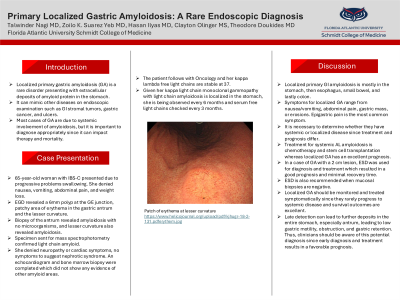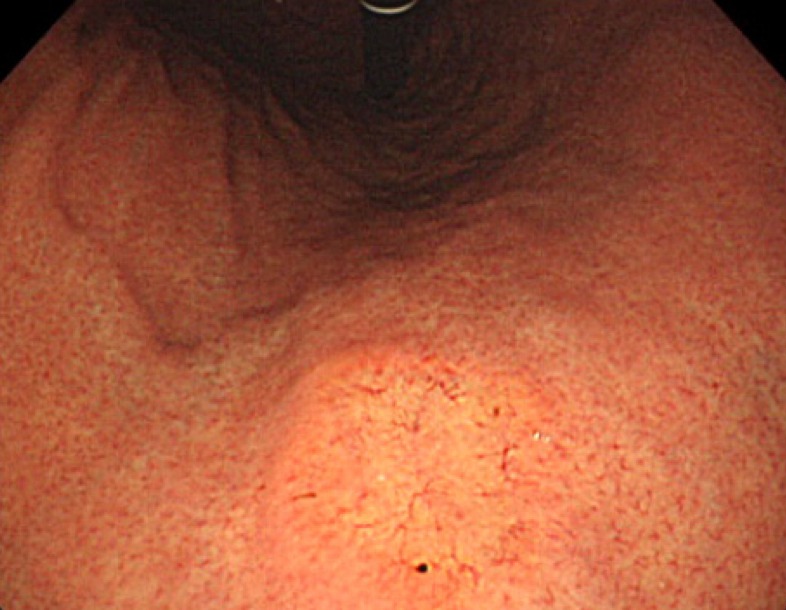Monday Poster Session
Category: Stomach
P3402 - Primary Localized Gastric Amyloidosis: A Rare Endoscopic Diagnosis
Monday, October 28, 2024
10:30 AM - 4:00 PM ET
Location: Exhibit Hall E

Has Audio

Talwinder Nagi, MD
Florida International University
Boca Raton, FL
Presenting Author(s)
Talwinder Nagi, MD1, Zoilo K. Suarez, MD2, Hasan Ilyas, MD2, Vismaya Mathew, MD2, Clayton Olinger, MS2, Theodore Doukides, MD3
1Florida International University, Boca Raton, FL; 2Florida Atlantic University, Charles E. Schmidt College of Medicine, Boca Raton, FL; 3Baptist Health, Boca Raton, FL
Introduction: Localized primary gastric amyloidosis (GA) is a rare disorder presenting with extracellular deposits of amyloid protein in the stomach. It can mimic other diseases on endoscopic examination such as GI stromal tumors, gastric cancer, and ulcers. Most cases of GA are due to systemic involvement of amyloidosis, but it is important to diagnose appropriately since it can impact therapy and mortality.
Case Description/Methods: 65-year-old woman with IBS-C presented due to progressive problems swallowing. She denied nausea, vomiting, abdominal pain, and weight loss. An EGD revealed a 6mm polyp at the GE junction, patchy area of erythema in the gastric antrum and the lesser curvature. Biopsy of the antrum revealed amyloidosis with no microorganisms, and lesser curvature also revealed amyloidosis. Specimen sent for mass spectrophotometry confirmed light chain amyloid. She denied neuropathy or cardiac symptoms, no symptoms to suggest nephrotic syndrome. An echocardiogram and bone marrow biopsy were completed which did not show any evidence of other amyloid areas. The patient follows with Oncology and her kappa lambda free light chains are stable at 37. Given her kappa light chain monoclonal gammopathy with light chain amyloidosis is localized in the stomach, she is being observed every 6 months and serum free light chains checked every 3 months.
Discussion: Localized primary GI amyloidosis is mostly in the stomach, then esophagus, small bowel, and lastly colon. The symptoms for localized GA range from nausea/vomiting, abdominal pain, gastric mass, or erosions. Epigastric pain is the most common symptom. For patients with amyloidosis, it is necessary to determine whether they have systemic or localized disease since treatment and prognosis differ. Treatment for systemic AL amyloidosis is chemotherapy and stem cell transplantation whereas localized GA has an excellent prognosis. In a case of GA with a 2 cm lesion, ESD was used for diagnosis and treatment which resulted in a good prognosis and minimal recovery time. ESD is also recommended when mucosal biopsies are negative. Localized GA should be monitored and treated symptomatically since they rarely progress to systemic disease and survival outcomes are excellent. Late detection can lead to further deposits in the entire stomach, especially antrum, leading to low gastric motility, obstruction, and gastric retention. Thus, clinicians should be aware of this potential diagnosis since early diagnosis and treatment results in a favorable prognosis.

Disclosures:
Talwinder Nagi, MD1, Zoilo K. Suarez, MD2, Hasan Ilyas, MD2, Vismaya Mathew, MD2, Clayton Olinger, MS2, Theodore Doukides, MD3. P3402 - Primary Localized Gastric Amyloidosis: A Rare Endoscopic Diagnosis, ACG 2024 Annual Scientific Meeting Abstracts. Philadelphia, PA: American College of Gastroenterology.
1Florida International University, Boca Raton, FL; 2Florida Atlantic University, Charles E. Schmidt College of Medicine, Boca Raton, FL; 3Baptist Health, Boca Raton, FL
Introduction: Localized primary gastric amyloidosis (GA) is a rare disorder presenting with extracellular deposits of amyloid protein in the stomach. It can mimic other diseases on endoscopic examination such as GI stromal tumors, gastric cancer, and ulcers. Most cases of GA are due to systemic involvement of amyloidosis, but it is important to diagnose appropriately since it can impact therapy and mortality.
Case Description/Methods: 65-year-old woman with IBS-C presented due to progressive problems swallowing. She denied nausea, vomiting, abdominal pain, and weight loss. An EGD revealed a 6mm polyp at the GE junction, patchy area of erythema in the gastric antrum and the lesser curvature. Biopsy of the antrum revealed amyloidosis with no microorganisms, and lesser curvature also revealed amyloidosis. Specimen sent for mass spectrophotometry confirmed light chain amyloid. She denied neuropathy or cardiac symptoms, no symptoms to suggest nephrotic syndrome. An echocardiogram and bone marrow biopsy were completed which did not show any evidence of other amyloid areas. The patient follows with Oncology and her kappa lambda free light chains are stable at 37. Given her kappa light chain monoclonal gammopathy with light chain amyloidosis is localized in the stomach, she is being observed every 6 months and serum free light chains checked every 3 months.
Discussion: Localized primary GI amyloidosis is mostly in the stomach, then esophagus, small bowel, and lastly colon. The symptoms for localized GA range from nausea/vomiting, abdominal pain, gastric mass, or erosions. Epigastric pain is the most common symptom. For patients with amyloidosis, it is necessary to determine whether they have systemic or localized disease since treatment and prognosis differ. Treatment for systemic AL amyloidosis is chemotherapy and stem cell transplantation whereas localized GA has an excellent prognosis. In a case of GA with a 2 cm lesion, ESD was used for diagnosis and treatment which resulted in a good prognosis and minimal recovery time. ESD is also recommended when mucosal biopsies are negative. Localized GA should be monitored and treated symptomatically since they rarely progress to systemic disease and survival outcomes are excellent. Late detection can lead to further deposits in the entire stomach, especially antrum, leading to low gastric motility, obstruction, and gastric retention. Thus, clinicians should be aware of this potential diagnosis since early diagnosis and treatment results in a favorable prognosis.

Figure: Patch of erythema at lesser curvature.
https://www.helicojournal.org/upload/pdf/kjhugr-18-2-131.pdf
https://www.helicojournal.org/upload/pdf/kjhugr-18-2-131.pdf
Disclosures:
Talwinder Nagi indicated no relevant financial relationships.
Zoilo Suarez indicated no relevant financial relationships.
Hasan Ilyas indicated no relevant financial relationships.
Vismaya Mathew indicated no relevant financial relationships.
Clayton Olinger indicated no relevant financial relationships.
Theodore Doukides indicated no relevant financial relationships.
Talwinder Nagi, MD1, Zoilo K. Suarez, MD2, Hasan Ilyas, MD2, Vismaya Mathew, MD2, Clayton Olinger, MS2, Theodore Doukides, MD3. P3402 - Primary Localized Gastric Amyloidosis: A Rare Endoscopic Diagnosis, ACG 2024 Annual Scientific Meeting Abstracts. Philadelphia, PA: American College of Gastroenterology.
